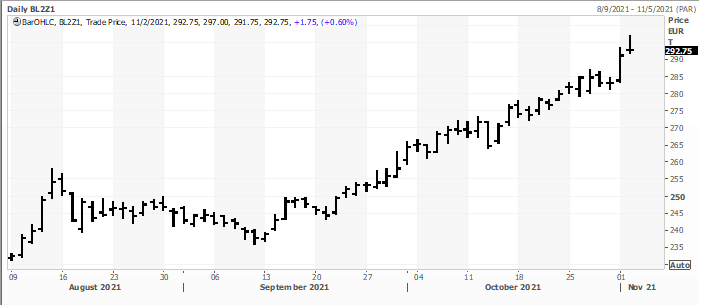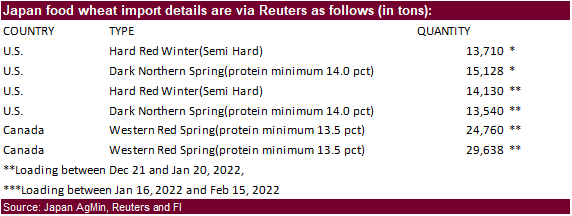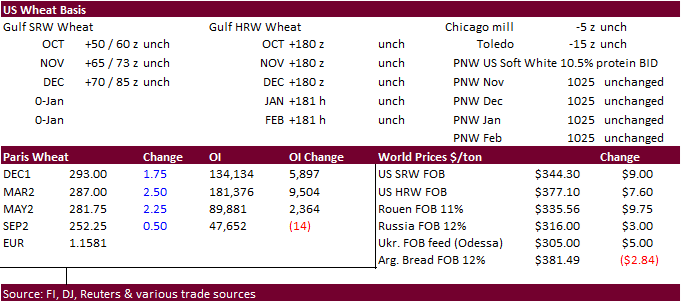PDF Attached
Soybean
meal rallied on talk of tight supplies across the ECB due to slow soybean harvesting. Soybeans closed higher and SBO mixed. Corn ended lower on renewed soybean/corn spreading. Chicago and KC wheat ended lower, and MN mixed.
Weather
World
Weather Inc.
MOST
IMPORTANT WEATHER AROUND THE WORLD
- Australia’s
eastern winter wheat, barley and canola areas will experience three rounds of rain in the next ten days resulting in a boost in soil moisture and slower crop maturation in some areas - The
situation needs to be closely monitored because of the risk of some areas possibly becoming too wet during the harvest - Australia
has a huge crop of wheat, barley and canola, but it would not take too much to reduce the quality of those crops by having rain fall frequently over the next several weeks
- La
Nina years due tend to bolster rainfall at harvest time - There
is no problem with the crops today….this is just a heads up to help awareness of what might be coming - Southern
India’s rainier weather pattern that is expected over the next week to ten days may disrupt farming activity, slowing the harvest and raising some summer crop quality concerns for maturing cotton, rice and a few oilseed crops - Northern
India will remain favorably dry over the next two weeks and planting of winter crops should advance well - Week
two of Russia’s Volga River Basin weather is advertised wetter in most of the computer forecast model runs today relative to the forecasts of earlier this week - The
European model has been advertising this change for a while - The
moisture boost will help improve soil moisture before frost gets into the ground
- The
moisture will help crop conditions improve in the spring as seasonal warming evolves - Soil
moisture is a little low in the Volga Basin, parts of Ukraine and Kazakhstan
- Bitter
cold air – the first of the season – occurred in northern parts of Russia’s eastern New Lands this morning with extreme lows to -26C or -15F - No
winter crops are produced in the region, but this was the coldest airmass of the season so far
- Canada
and the northwestern U.S. Plains have also experienced bitter cold this week with a few temperatures below zero Fahrenheit in the drier areas of western Canada and north-central Montana - Warming
is likely, although precipitation will continue lacking in many areas - U.S.
harvest weather improved for many areas Monday, but cool temperatures kept drying rates a little slow warranting more drying time before aggressive fieldwork can resume - Rain
in the southern Plains and U.S. Delta over Wednesday into Thursday will further delay farming activity, but the resulting rainfall should be brief and light - A
more active U.S. weather pattern will begin in the Midwest during the second half of next week; until then improved field conditions and slowly increasing harvest activity is expected - West-central
and southwestern U.S. hard red winter wheat production areas will continue drier biased for the next two weeks, despite a few showers over the next few days - Montana
will continue too dry along with central parts of Canada’s Prairies - Drought
relief for these areas is not expected anytime soon - U.S.
southeastern states will see a good mix of rain over the next couple of weeks ensuring good harvest progress - Any
showers that occur will be brief and light - Argentina
weather will remain well mixed into the coming weekend with additional rain late this week into Saturday for most of the nation - That
rain and the moisture that has occurred earlier this week will improve wheat development and production potential - The
moisture will also be good for corn, sorghum, peanut and soybean planting - Next
week’s weather will be drier across Argentina raising the need for additional timely rainfall after mid-month - All
of Brazil’s crop areas will get rain at one time or another during the next two weeks
- Precipitation
will be lightest and most infrequent in the interior parts of southern Brazil; including parts of Sao Paulo and Parana. - Excessive
rainfall is expected in a part of northeastern Brazil during the coming week to ten days and that may lead to some flooding and a little replanting
- Bahia,
Minas Gerais, a part of Tocantins and northern Goias should be wettest - Brazil
temperatures will be near to below average over the next ten days - Argentina
temperatures will trend a little warmer during the next few days and especially next week after some late week and weekend cooling
- South
Africa will start receiving some needed rain in the central and eastern summer crop areas later this week that will last through much of next week - The
moisture will improve planting, germination and emergence conditions - Temperatures
will be warmer than usual in the northeast and slightly below average in the southwest through the next week - Eastern
China will trend drier and much colder next week after this week’s weather includes frequent showers and a few thunderstorms and warm temperatures - Rain
will impact many grain and oilseed production areas from Friday of this week through Tuesday of next week
- Fieldwork
will be slowed during that period of time, but drying in the following week will support improved harvest conditions - Northeastern
Xinjiang, China will see good harvest weather until Wednesday and Thursday when showers are expected to delay farming activity - An
extended period of drier weather will then occur from late this week through most of next week to help get harvest back under way - Central
and western Xinjiang harvest weather will be nearly ideal during the next couple of weeks with only a few brief showers of insignificance expected late this week - Indonesia
and Malaysia weather will be wet biased over the next two weeks with frequent rain expected over saturated or nearly saturated soil causing some flooding - Coastal
areas of southern Vietnam will likely trend wetter than usual next week, but restricted rainfall is expected until then - Philippines
weather will remain favorably mixed with rain and sunshine through the next two weeks - Portions
of North Africa will get some needed rain late this week through the weekend - Northwestern
Algeria may get some excessive rain resulting in some coastal flooding - Northwestern
Algeria has been drier than usual in recent past years and this will be a good opportunity to improve soil moisture and water supply ahead of aggressive wheat and barley planting - Southwestern
Morocco remains in a multi-year drought with little rain of significance expected over the next couple of weeks - West-central
Africa will experience a good mix of weather during the next ten days to two weeks - Less
frequent rain in cotton areas will translate into better crop maturation conditions - Coffee,
cocoa, sugarcane and rice will also benefit from less frequent and less significant rainfall, although completely dry weather is not likely for a while - East-central
Africa rainfall will be favorably mixed for a while supporting coffee, rice, cocoa and a host of tropical crops - Europe
weather will be favorably mixed over the next two weeks. Rainfall will be most significant in southern France, eastern Spain, Italy and the eastern Adriatic Sea region this week with significant rain continuing in eastern Spain next week while the North and
Baltic Sea region’s trend wettest - Southeastern
Europe will be driest relative to normal for the next two weeks. - Mexico’s
greatest wet weather anomaly will occur in Jalisco, Colima, Michoacan and Guerrero during the next two weeks with above average rainfall expected - Some
showers will occur along the east coast as well - Most
other areas will experience seasonal drying - Central
America rainfall will be erratic over the next two weeks with the greatest rain expected in Costa Rica and Panama - Western
and northern Colombia, Ecuador and Peru agricultural areas will be closely monitored over the next few weeks as the potential for flooding increases.
- The
risk may be greatest starting in the second week of the forecast and continuing into mid-November.
- Coffee,
sugarcane, corn and a host of other crops may eventually impact by too much rain in Colombia
- Western
Venezuela may also be involved with the excessive moisture - Central
Asia cotton and other crop harvesting will advance swiftly as dry and warm conditions prevail - Today’s
Southern Oscillational Index was +6.69 and it was expected to drift a little lower over the next few days, although it should gradually level off - New
Zealand weather is expected to be drier than usual during the coming week except in eastern parts of North Island where some heavy rain is possible - Temperatures
will be seasonable. - Tropical
Storm Wanda was 800 miles west of the Azores and expected to move closer to the islands this weekend
The
storm poses no threat to North America and is a minimal threat to western Europe
Tuesday,
Nov. 2:
- New
Zealand global dairy trade auction - EU
weekly grain, oilseed import and export data - HOLIDAY:
Brazil
Wednesday,
Nov. 3:
- EIA
weekly U.S. ethanol inventories, production - HOLIDAY:
Japan
Thursday,
Nov. 4:
- FAO
World Food Price Index - USDA
weekly crop net-export sales for corn, soybeans, wheat, cotton, pork and beef, 8:30am - New
Zealand Commodity Price, 8pm Wednesday ET time - Port
of Rouen data on French grain exports - HOLIDAY:
India, Malaysia, Singapore
Friday,
Nov. 5:
- ICE
Futures Europe weekly commitments of traders report (6:30pm London) - CFTC
commitments of traders weekly report on positions for various U.S. futures and options, 3:30pm - China’s
CNGOIC to publish demand-supply reports on corn, soy and other commodities - FranceAgriMer
weekly update on crop conditions - Malaysia
Nov. 1-5 palm oil exports - HOLIDAY:
India
Source:
Bloomberg and FI
USDA
baseline tables
will be released on Nov. 5, ahead of the release in February of the full 100-page “Agricultural Projections to 2031” report. These tables should offer USDA’s unofficial view on 2022 plantings, using the Oct WASDE report as a starting point. Full USDA press
release: https://bit.ly/3mglSZx
(Reuters)
Macros
Canada
Building Permits (M/M) Sep: 4.3% (est 3.0% prev -2.1%; prevR -2.0%)
Corn
·
Corn futures ended lower on weakness in wheat and renewed soybean/corn spreading. Lack of US corn developments are also weighing on prices. Some trade groups are projecting a rice in the US corn yield when updated early next
week.
·
Funds sold an estimated net 4,000 corn contracts.
·
The Chinese government urged people to stock up on food ahead of the winter in case of emergencies, such as supply shortages. They have already seen some people stock up on rice, cooking oil and salt. The government issued a
similar warning about a year ago.
·
Reuters ran a story on China pig production and the recent expansion has been more robust than planned. They noted prices “hover below the cost of production and the government urges them to cull their herds,”, despite government
recommendations for producers to scale back on herds. They went onto say “surging output and COVID-linked demand interruptions have driven down prices by 70% this year, causing heavy producer losses over the past three months.”
·
A Bloomberg poll looks for weekly US ethanol production to be up 2,000 barrels (1035-1139 range) from the previous week and stocks up 106,000 barrels to 20.031 million.

Export
developments.
-
None
reported

Updated
11/01/21
December
corn is seen in a $5.30-$6.10 range
March
corn is seen in a $5.25-$6.25 range
·
CBOT soybeans ended higher following a very strong soybean meal market. We are hearing meal basis is strong across the ECB due to slow harvesting pace and some crushers are having a hard time keeping up with the meal demand.
There was a rumor of one major processor had slowed or stopped crushing in central IL, but we could not verify this. Note soybean meal basis today was widely steady across the Corn Belt. Soybean oil ended mixed to mostly moderately lower. WTI crude was
down $1.14.
·
We slightly lifted out US soybean export crop year projection, by 10 million bushels, after adjusting October shipments, but are still 40 million below USDA.
·
Attached are revised product and soybean balances for the US.
·
Funds bought an estimated net 6,000 soybeans, bought 7,000 soybean meal and were even in soybean oil.
·
China in a state reserve auction sold 100% of soybeans offered, or 52,395 tons.
·
Argentine producers sold 33.1 million tons of soybeans from the 2020-21 season, according to the AgMin, below 34.4 million tons year ago. 2021-22 soybean commitments are running at 2.6 million tons.
Export
Developments
·
Egypt’s GASC seeks 30,000 tons of soybean oil and 10,000 tons of sunflower oil on Wednesday for arrival between Dec. 25 and Jan. 15 from Dec. 20 to Jan. 10, with 180-day letters of credit and/or at sight.
·
Results awaited: The USDA seeks 20 tons of vegetable oil in 4-liter cans for Dec 1-13 shipment on November 2.

Updated
11/01/21
Soybeans
– November $11.50-$13.00 range, March $11.50-$13.50
Soybean
meal – December $295-$335, March $300-$360
Soybean
oil – December 59.50-64.50 cent range, March 56-65
·
US wheat futures started higher on follow through strong global demand but ended lower from a rally in the USD that generated profit taking. MN did end mixed. KC lost 3.25-8.25 cents and Chicago was down 2.0-5.75 cents. This
was a little surprising as US HRW wheat class conditions triggered the downgrade in US winter wheat good/excellent conditions last week. Japan is in for food wheat which is routine. EU wheat demand is robust.
·
News developments were slow after the open.
·
Funds sold an estimated net 4,000 Chicago wheat contracts.
·
Paris December wheat was up 1.75 at 292.75, an all-time high.
·
Ukraine 2022 winter wheat plantings reached 91 percent of the intended area or 6.1 million hectares as of November 1. 6.68 million hectares is what the AgMin expects for plantings.
·
US Great Plains weather improves this week with some showers early to mid-week across the southern Great Plains.
December
Paris wheat

Export
Developments.
·
Japan seeks 143,396 tons of food wheat.

·
Pakistan issued an import tender for 90,000 tons of wheat set to close Nov. 4 for Jan through April shipment.
·
Ethiopia seeks 300,000 tons of milling wheat on November 9.
·
Ethiopia seeks 400,000 tons of wheat on November 30.
Rice/Other
·
Results awaited: Maldives seeks 25,000 tons of parboiled rice with offers due by October 28.

Updated
11/01/21
December
Chicago wheat is seen in a $7.30‐$8.25 range, March $7.25-$8.40
December
KC wheat is seen in a $7.35‐$8.35, March $7.00-$8.50
December
MN wheat is seen in a $9.70‐$11.50, March $9.00-$11.75
Terry Reilly
Senior Commodity Analyst – Grain and Oilseeds
Futures International
One Lincoln Center
18 W 140 Butterfield Rd.
Oakbrook Terrace, Il. 60181
W: 312.604.1366
ICE IM:
treilly1
Skype: fi.treilly

Trading of futures, options, swaps and other derivatives is risky and is not suitable for all persons. All of these investment products are leveraged, and you can lose more than your initial deposit. Each investment product is offered
only to and from jurisdictions where solicitation and sale are lawful, and in accordance with applicable laws and regulations in such jurisdiction. The information provided here should not be relied upon as a substitute for independent research before making
your investment decisions. Futures International, LLC is merely providing this information for your general information and the information does not take into account any particular individual’s investment objectives, financial situation, or needs. All investors
should obtain advice based on their unique situation before making any investment decision. The contents of this communication and any attachments are for informational purposes only and under no circumstances should they be construed as an offer to buy or
sell, or a solicitation to buy or sell any future, option, swap or other derivative. The sources for the information and any opinions in this communication are believed to be reliable, but Futures International, LLC does not warrant or guarantee the accuracy
of such information or opinions. Futures International, LLC and its principals and employees may take positions different from any positions described in this communication. Past results are not necessarily indicative of future results.


